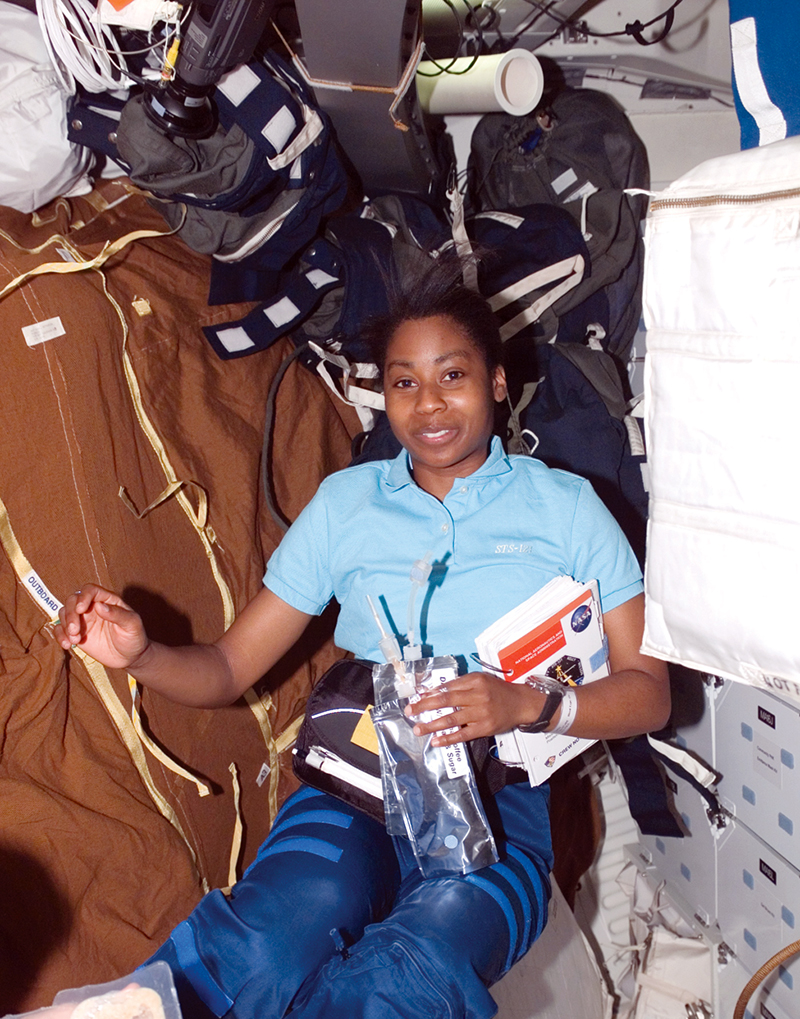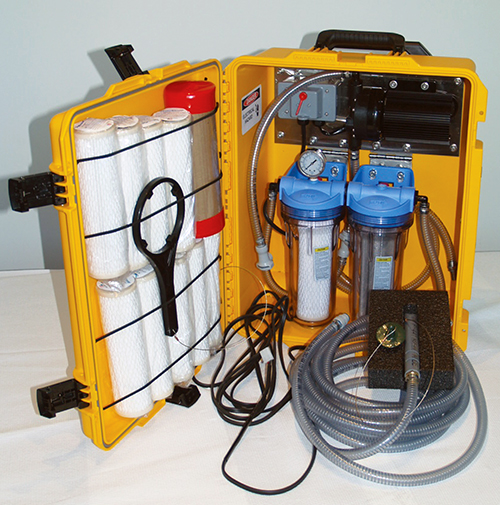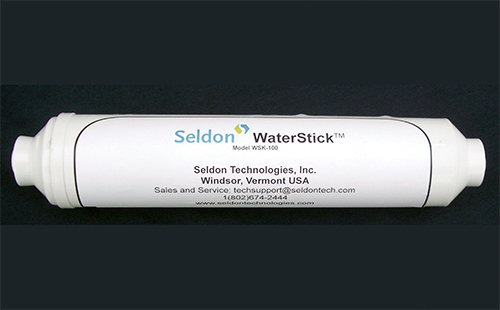
Portable Nanomesh Creates Safer Drinking Water
Originating Technology/NASA Contribution
Providing astronauts with clean water is essential to space exploration to ensure the health and well-being of crewmembers away from Earth. For the sake of efficient and safe long-term space travel, NASA constantly seeks to improve the process of filtering and re-using wastewater in closed-loop systems. Because it would be impractical for astronauts to bring months (or years) worth of water with them, reducing the weight and space taken by water storage through recycling and filtering as much water as possible is crucial. Closed-loop systems using nanotechnology allow wastewater to be cleaned and reused while keeping to a minimum the amount of drinking water carried on missions.
Current high-speed filtration methods usually require electricity, and methods without electricity usually prove impractical or slow. Known for their superior strength and electrical conductivity, carbon nanotubes measure only a few nanometers in diameter; a nanometer is one billionth of a meter, or roughly one hundred-thousandth the width of a human hair. Nanotubes have improved water filtration by eliminating the need for chemical treatments, significant pressure, and heavy water tanks, which makes the new technology especially appealing for applications where small, efficient, lightweight materials are required, whether on Earth or in space.
“NASA will need small volume, effective water purification systems for future long-duration space flight,” said Johnson Space Center’s Karen Pickering. NASA advances in water filtration with nanotechnology are now also protecting human health in the most remote areas of Earth.
Partnership
In 2003, Seldon Laboratories LLC, of Windsor, Vermont, received their first NASA Small Business Innovation Research (SBIR) award for a “Nanomechanical Water Purification Device.” In Phase I, Seldon designed a filtration system using its proprietary filters with low-energy and low-space requirements, using carbon nanotubes to reduce the power requirements of closed-loop water (and other liquid) treatment systems and to eliminate hazardous chemical treatments.
Seldon patented a media for a lightweight, low-pressure water purifier that used carbon nanotubes to remove microorganisms from large quantities of water quickly; the production process fused the nanotubes into a membrane. After 2 years of testing, in-house data indicated that the Seldon filters reliably removed waterborne viruses and bacteria. Each cylindrical filter cleaned water successfully for 40-60 days, surpassing the NASA requirements for 30-day missions.
Phase II of the SBIR agreement included treating higher volumes of water with larger membranes; carbon nanotubes were connected into a mesh. Engineers studied filter regeneration and bio-film abatement techniques for extending filter life, and subjected the filter elements to chemical removal testing. Although Seldon designed the membranes for bio-removal (including viruses and bacteria), the filters also removed some contaminants and chemicals—Seldon scientists affirm specific chemical adsorption can be engineered into the nanotubes for future projects.
Testing in U.S. Environmental Protection Agency-certified facilities showed that Seldon’s Nanomesh removed microorganisms such as bacteria (99.9999 percent, or 6 log), viruses (99.99 percent, or 4 log), Cryptosporidium parvum, Giardia lamblia, and chemical contaminants including arsenic, lead, benzene, copper, dioxins, herbicides, mercury, and endotoxins, such as Escherichia coli (E.coli) and Salmonella.
Seldon designed, constructed, and tested prototypes of the final Nanomesh filter, before delivering them to NASA in November 2006. Seldon’s filters have potential applications in industrial water purification systems, industrial decontamination, and commercial and household use.
Product Outcome
The commercial version of the carbon Nanomesh designed under the NASA SBIR agreement was released as the WaterStick. Operating as simply as a straw and almost as small, the WaterStick cleans about 5 gallons (200 milliliters) of water per minute simply using water pressure (up to 3 PSI) and gravity: without electricity, heat, environmental impact, or chemical additives (such as iodine or chlorine used by other filters).
The lightweight filters measure about 10½ inches by 2 inches (27 cm by 5 cm), or similar in size to a zucchini. The WaterStick also removes chlorine and iodine, thereby creating water that is not only potable, but palatable as well. Lastly, the WaterStick is easy to use, requiring only a simple filter change every 7 weeks (for one person) or 73 gallons (275 liters.) The manufacturer considers the WaterStick to be “perfect for short-duration uses where other solutions are impractical.”
The ease and portability of the WaterStick makes it useful for a variety of applications in which access to clean water and electricity are restricted, such as remote locations or disaster areas. The Seldon WaterStick weighs only 8 ounces and is sold as a standalone device through which water can be poured. Seldon is currently targeting the lightweight WaterStick to disaster relief workers, researchers, and military personnel in remote locations with no wastewater facilities; future markets may include recreational hikers.
In locations where waterborne illness can prove disastrous, clean water is even more essential. The water filtration element achieves a high level of bacteria and virus removal while maintaining high flow rates and low pressure drops across the filter’s surface. According to Seldon CEO Alan Cummings, “Seldon products containing Nanomesh can provide mobile, life-saving ground and surface water filtration in field and disaster relief environments by removal of microorganisms that cause waterborne diseases.”
Most of the other commercial water filters do not offer the same level of filtration as the WaterStick; those employing a charcoal or ceramic filter are often less effective against viruses, and those offering comparable protection employ chemicals. Alternately, products that offer a high level of filtration may use ultraviolet light and thereby require batteries or electricity. Ultraviolet water treatment works well, but tends to be less effective in highly contaminated water with a high percentage of particulates. Seldon engineer Jonathan Winter states, “Our technology is superior, because it doesn’t need a certain amount of time or electricity.”
Seldon plans to develop an under-the-sink water filtration unit for residential use; like the WaterStick, these larger units would use water pressure to push water through the Nanomesh, and would not require electricity. Other target areas for development may include industrial purification, decontamination, and desalination.
Seldon WaterStick™ and Nanomesh™ are trademarks of Seldon Technologies Inc.

Recently used in Rwanda, Seldon’s WaterBox is the size of a small suitcase and is capable of supporting the water needs of a small village.

Comparable in size to a zucchini and operated like a straw, Seldon’s WaterStick cleans water by using nanotechnology to remove sediment, chemicals, bacteria, viruses, and microorganisms.

Research into providing clean drinking water for astronauts like Stephanie Wilson, STS-121 mission specialist, has yielded new water filtration products on Earth.













